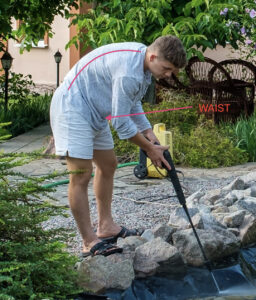Here are two men doing similar tasks while power cleaning an artificial pond. They both bend forward to work. But that’s where the similarity ends.
One of these men is practicing safe bending, and the other isn’t.
One of them will tire sooner than the other, and he’s much more likely to feel back pain.
Ironically, it is likely that these men have no idea that they bend differently. They just bend the way they do and don’t think about it. That’s true for most of us until we have a reason to learn about our bending habits. Sadly, the reason is likely to be an experience of agonizing back pain.
Maybe it has happened to you. You bent forward to make the bed, your back went into spasm, and you couldn’t get off the floor for a few days. Or you woke up one day and had a radiating pain down your leg that made it impossible to walk. Maybe sitting to work at a computer causes such neck pain that you lie down to work.
Isn’t it time to find out the causes of all this suffering?
In fact, the answer is simple: the most dangerous thing you can do to your spine is to bend at your waist. But what does that mean? What does unsafe bending look like? And better still, what does safe bending look like?
Check out the two men in the photo above. Quick, can you tell which one is in danger of ruining his back from his everyday bending?
It’s the man on the left because he bends at his waist. If the answer didn’t jump out at you, that’s because, in our culture, almost everyone bends at the waist. We see this dangerous form of bending so often that it seems normal, and we no longer really “see” it. We certainly don’t see the damage it’s doing.

When this man bends at his waist it’s really his spine doing the bending. Instead of stacking evenly, the vertebral bodies – the thick oval segments of bone in the front of the spine – tip. The front of his spine is compressed. In fact, his spine is falling and he needs tight back muscles to hold him in this position. This man is uncomfortable in his back. It’s misaligned and overworking. However, since he always bends like this he’s used to it and just endures it as best he can.
The man on the right of the photo bends at his hip sockets. Bending at the hip sockets is the secret of safe bending. Look at the horizontal red arrow to see the depth of his bend.

When he bends at his hips, his spine stays “straight.” This alignment allows his body weight to go through his vertebral bodies. The muscles stabilize the spine but they don’t carry its weight. Instead, his weight stays in his bones. He is comfortable with his movements. What he’s doing feels like work, but he’s not suffering from undue pressure in his back. His muscles may feel tired, but they won’t be painful. Working in alignment feels like a good workout, not a chore to be endured.
Once you know the difference between safe and dangerous bending, daily life will become a continual wake-up call. Every time you see someone bending from their waist – and you’ll see it all the time – let it be a reminder for you to take care of yourself by bending at your hips. So few people bend at their hips that when you do so, you’ll be setting a good example.
How can you avoid slipping back into seeing dangerous posture as normal?
Attend class, learn the guidelines, and take care of your spine by always bending well. Your whole being flourishes by doing so.


